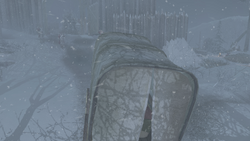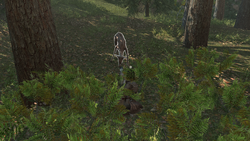A rooftop garden in Damascus
Hiding spots referred to different types of hiding places which were used by various members of the Assassin Order to escape pursuers after breaking their line of sight, or performing an ambush.
Third Crusade
During the Third Crusade, hiding spots played a significant role for Assassins, since they frequently were their only way to successfully escape from a group of pursuers. Depending on the situation, Assassins could have used different kinds of hiding spots.
Benches
When there were at least two people sitting on benches, an Assassin could sit between them with his head down to hide from pursuers. The Assassin had a higher risk of being detected while on a bench compared to other hiding spots.
Haystacks
Of all hiding spots, haystacks were the ones that offered the most tactical use. Since they could appear both on rooftops and on the ground, they were always a good hiding place. Moreover, a Leap of Faith could be performed from a rooftop into them. Haystacks usually appeared in two different versions: as a pile or in a cart, either yellow or green.
Rooftop gardens
Rooftop gardens were small booths which were covered with curtains on the inside. Thus, they provided an easy escape for Assassins. They appeared on rooftops ubiquitously throughout the Holy Land. Their appearance could differ depending on the city and the district. Rooftop gardens in poorer districts were usually flat, whereas the ones located in the richer districts were often decorated with ornaments and had a small, sometimes gilded, cupola.
Renaissance
During the Renaissance, hiding spots were once again quite important for the Assassins. Although they were able to escape from pursuers by breaking the line of sight or fleeing the area, hiding spots still offered an alternative way to escape. However, guards became more suspicious during that time period and often searched hiding spots for their targets.
Balconies
Balconies were a variant of rooftop gardens which could be found in Constantinople. However, they never appeared on top of a roof and could only be accessed by climbing the conjoined wall.
Carts
A rose-leaf cart in Florence
Haystacks worked exactly the same as during the Third Crusade. However, they were now rarely found on rooftops, and were instead usually in carts on the ground. Depending on the city, the hay was also often replaced with other things, such as rose leaves in more exalted cities such as Florence or Rome, or green leaves in more rural areas such as San Gimignano.
In certain locations, such as Constantinople, Castel Gandolfo or San Donato, large bushes could be found instead of haystacks. However, the visual nature was the only difference between them.
Rooftop gardens
Rooftop gardens were still present during the Renaissance and had a similar style in most cities, usually only differing in the color of the curtains. However, Rome, Constantinople and Venice had rooftop gardens with a unique, posher style, usually decorated with ivy or wine ranks.
Tents
Tents appeared in Constantinople and could be found in both Topkapı Palace and the Janissary camp. They worked essentially the same as haystacks although, unlike them, tents could only be accessed from two sides.
Water
Water provided an easy way to escape for Assassins, since they could jump into it from nearly every height without being hurt. Moreover, they could simply dive in order to break the line of sight with their pursuers.
Wells
Wells appeared during the Renaissance everywhere throughout Italy. They worked similar to haystacks, but Assassins could not perform a Leap of Faith into them. Wells, apart from haystacks, were the only places which were always scanned by cautious Borgia Seeker guards in Rome. Their visual appearance changed depending on the city they were located in.
Although existing in Constantinople too, most of the wells in the city were boarded-up with wooden planks. These could only be removed by using certain bombs.
American Revolution
Hiding spots played a smaller part in the cities of Boston and New York as Assassin Recruits could disguise themselves as Redcoats, giving Connor a mobile hiding spot whenever he wanted. Guards also remembered where Connor hid if they investigated him, forcing him out of hiding. However, hiding spots played a big role in hunting, allowing Connor to get very close to animals. This was an advantage because he could assassinate the animal, giving the best quality of kill and usable parts.
Carts

Haytham Kenway hiding in a wagon
Carts were once again prominent, and functioned as they did in the Renaissance, with the exception of the covered wagon, which could only be entered from the back and was impossible be used as a landing spot for the Leap of Faith. Ratonhnhake:ton is forced out of carts if the guards are investigating them.
Moving carts
A variation on the cart, the moving cart was simply a horse-drawn cart. Convoys had special carts that could be looted by entering them.
Tree branch piles
What was either evergreen tree branches in piles or a fallen evergreen trees are scattered about the Frontier and Davenport Homestead. They could be used for a Leap of Faith and were often under high points in the Frontier.
Tall plants

Ratonhnhaké:ton hiding among plants while hunting a deer
Tall, thick patches of plants could be used as hiding spots, where Connor, crouched down, could hide and move slowly about in it, hiding his movements or run through it with no ill effects. These hiding spots were very effective for use in hunting, as he could hide near the edge of the patch and throw bait to attract animals to assassinate, or hide in to get within bow-shot range. Although rare, they could be found in cities, mostly in rural areas.
Wells
Wells functioned exactly the same way as they did in the Renaissance.

